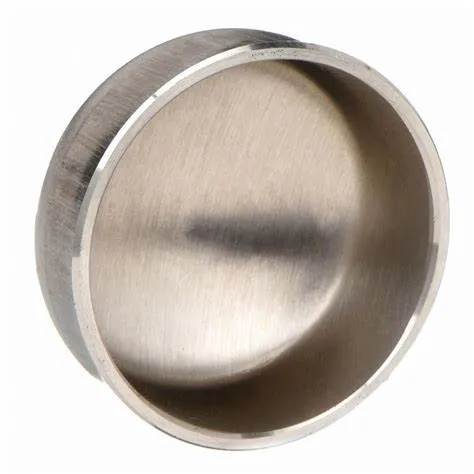JIS B2311 ass e japanesche Industriestandard deen Hënneschten-Schweiß-Päiffittings ofdeckt, inklusiv Kappen, déi a Päifsystemer benotzt ginn. Butt-Schweißkappen déngen den Zweck fir d'Enn vun enger Päif zou ze maachen, e Sigel ze bidden fir Leckage oder Kontaminatioun ze vermeiden. Hei ass eng Aféierung zu JIS B2311 Butt-Schweißkappen:
- 1. JIS B2311 Standard:
- - JIS B2311 Standard spezifizéiert d'Ufuerderunge fir den Design, Dimensiounen, Materialien, Fabrikatioun, an Testen vun Hënneschten-Schweißarmaturen, dorënner Kappen, a Pipesystemer.
- - De Standard garantéiert datt Kappen, déi am Aklang mat JIS Standards produzéiert ginn, Qualitéitsnormen entspriechen a kompatibel sinn mat anere Pipingkomponenten.
- 2. Butt-Welding Cap:
- - Eng Hënneschten-Schweißkappe, laut JIS B2311, ass e Fitting entwéckelt fir d'Enn vun enger Päif sécher ze decken an ze versiegelen, Schutz ze bidden an d'Integritéit vum Päifsystem z'erhalen.
- - Kappen ginn a Situatiounen benotzt, wou d'Päif-Enn Zoumaache erfuerdert, entweder permanent oder temporär, fir Leckage, Kontaminatioun ze vermeiden oder fir de System fäerdeg ze maachen.
- 3. Material a Konstruktioun:
- - Butt-Schweißkappen ënner JIS B2311 Spezifikatioune sinn a verschiddene Materialien wéi Kuelestol, Edelstahl a Legierungsstahl verfügbar fir verschidden Applikatiounsufuerderungen ze treffen.
- - Dës Kappen gi mat standardiséierte Konstruktiounsmethoden hiergestallt fir eng staark a leckfräi Verbindung ze garantéieren wann se um Enn vun enger Päif geschweest ginn.
- 4. Uwendung a Virdeeler:
- - Butt-Schweißkappen fannen Uwendungen a verschiddenen Industrien, dorënner Ueleg a Gas, chemesch Prozesser, Waasserbehandlungsanlagen, a méi, wou Päifendunge sécher musse ofgedeckt ginn.
- - Kappen bidden Schutz fir Päifen aus Ëmweltelementer, verhënneren Kontaminatioun, an hëllefen d'Propperheet an d'Integritéit vum Päifsystem z'erhalen.
- 5. Installatioun a Schweess:
- - Richteg Installatiounspraktiken, inklusiv korrekt Ausrichtung, Virbereedung vum Päifend, a Schweißtechniken, si wesentlech wann Dir Hënneschten-Schweißkappen installéiert fir eng enk a leckbeständeg Dichtung ze garantéieren.
- - Schweißen ass eng gemeinsam Method fir Kappen un Päifen ze befestigen, fir eng sécher a permanent Zoumaache ze bidden déi Drock, Temperaturvariatioune a Flëssegkeet am System widderstoen kann.
- Zesummegefaasst, JIS B2311 Hënneschten-Schweißkappen sinn entscheedend Komponenten déi a Päifsystemer benotzt ginn fir d'Enn vu Päifen sécher ze versiegeln an ze schützen. Dës Kappen entspriechen standardiséierte Ufuerderunge fir Qualitéit, Zouverlässegkeet a Kompatibilitéit bannent industriellen Uwendungen ze garantéieren, wou Päifschließung a Schutz noutwendeg sinn.
What Is a Butt Welding Cap and How Is It Used in Industrial Piping?
In industrial piping systems, end-of-line sealing and branch closures require robust solutions. A butt welding cap serves as a critical component for terminating pipes securely. By providing a seamless, welded closure, this fitting maintains system integrity, prevents leaks, and supports compliance with industry standards.
What Is a Butt Welding Cap?
A butt welding cap—also called a pipe end cap or buttweld end cap—is a round fitting designed to close off the end of a pipe. It’s manufactured to match the pipe’s outer diameter and schedule, with either a hemispherical or flat face. To install, both the pipe end and cap are beveled to form a V‑groove, enabling full‑penetration, fusion welds. Common materials include carbon steel, stainless steel, nickel alloys, and other engineered grades, chosen to satisfy pressure, temperature, and corrosion‑resistance requirements.
How Is Butt Welding Cap Used in Industrial Piping?
Butt welding caps find application across oil & gas, petrochemical, power generation, water treatment, and general process industries for both permanent and temporary closures. During hydrostatic testing, technicians install caps to seal off sections of piping while monitoring for leaks. In new construction or retrofit projects, caps terminate branch lines, future tie‑in spools, or dead‑end mains until system expansion. Welders prepare each joint by cleaning and beveling surfaces, aligning the cap precisely, and executing a root pass followed by filler passes per the qualified Welding Procedure Specification (WPS). Post‑weld heat treatment and non‑destructive examination (NDE)—such as radiography or ultrasonic testing—verify weld integrity and compliance with ASME B16.9 and related standards. Additionally, temporary caps enable safe isolation during maintenance, allowing for segment testing and dewatering under regulatory protocols.
Benefits and Best Practices
Butt welding caps offer a smooth‑bore transition that minimizes flow disruption and stress concentration. Their full‑penetration welds deliver exceptional structural strength and leak resistance. To optimize performance, engineers should:
Select caps with matching material grades and wall thicknesses
Adhere to proper bevel angles and joint fit‑up tolerances
Follow qualified WPS protocols rigorously
Consider cladding or protective coatings in corrosive environments to extend service life
Regular inspection and thorough documentation ensure long‑term reliability and safe operation under demanding conditions.
Butt welding caps are indispensable components for achieving durable, leak‑proof pipe terminations in a wide range of industrial applications.
Butt Welding Cap FAQs
What is a butt welding cap?
|
What materials are commonly used?
|
What standards govern butt welding caps?
|
How are butt welding caps installed?
|
Where are butt welding caps typically used?
|
What are the advantages of threaded caps?
|
















